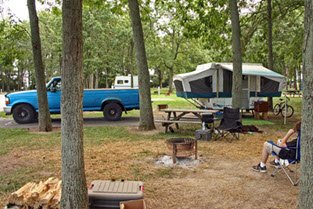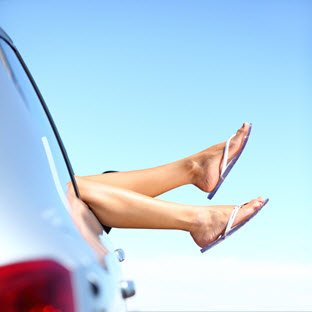
Written by Kayla Jane Barrie Updated on Nov 20, 2025 7 mins read

Whether you are planning a summer vacation or a long weekend getaway, taking a road trip is one of the most popular ways to get away, explore, and enjoy some much-needed time off.
If you want to avoid getting caught in the bottleneck of summer and long weekend traffic, use the following long weekend driving tips to help minimize the stress and frustration you may experience as you travel during your summer vacation.
When you travel can be just as important as where you travel during the summer. We all want to avoid getting stuck in traffic, especially in the GTA during rush hour and high-volume traffic times. The province has long been known for its summer mass exodus, especially on long weekends, as people escape the Greater Toronto Area – and other large urban centres – to head up to cottage country and popular vacation destinations.
Road congestion during the summer is inevitable. With construction season in full swing and no shortage of local drivers and tourists clogging the highway, it can be easy to get frustrated, which can lead to instances of road rage and accidents – slowing down traffic even more.
No one wants their summer vacation plans to get derailed by unforeseen traffic. When planning your summer road trip, try to avoid driving during these times:
As a general rule, it's a good idea to avoid driving during rush hour in any city, but especially in Toronto. The amount of time you expect to spend on the road can quickly double or triple and without a moment's notice.
BlogTo provides some insight into the best time to avoid driving (and taking the TTC) during the summer :
"There are three distinct rush hours in Toronto. The first, between 8:00 a.m. and 9:00 a.m., is when both highway speeds and transit crowding are worst. In the afternoon, the second rush between 3:30 and 4:30 p.m. is when the DVP and Gardiner are slowest. The third rush, slightly later between 5:00 and 6:00 p.m., is when the TTC is most claustrophobic."

Summer long weekends in Ontario are when you will find some of the province's most congested highways and roads, especially if you are heading toward cottage country, the beach, or popular summer tourist spots.
From the Victoria Day long weekend until Labour Day, you can count on traffic jams on the 400-series highways. Here is a list of summer long weekends:
Mother's Day and Father's Day can also be busy travel times as families head out to spend quality time together.
Whether you are heading north on Highway 400 on your way to Muskoka, or to other popular cottage locations in Ontario, such as Haliburton, Niagara on the Lake, Tobermory or the Bruce Peninsula, you can expect to get caught in a cottage country traffic jams every Friday and Sunday.
While many take vacations in late spring and early summer, the summer vacation season in Ontario really kicks into high gear once the school year ends. July is the most popular month for summer vacations, followed by August.
The key to a successful summer holiday is to plan ahead, especially if you will be driving. Here are some summer driving tips that will help you plan your trip:
When you depart for your trip will play a big role in how long it will take to get to your destination. To avoid the traffic, it's recommended that you either leave early in the morning, or wait until the evening rush hour traffic subsides. The Ontario Provincial Police recommend to "go home, have a nice dinner and then think about getting on the road." It's about finding an alternate departure time for the cottage, leaving after or before most other drivers do.

Consider the "scenic route." Traffic volume increases by 20% on long weekends. Think about taking the road less travelled – maybe a secondary or country road. Even though you won't be able to drive as fast and it may not be a direct route, you may get there faster than if you took a 400-series highway.
Checking your car, especially if it is older, should be part of your summer driving trip planning. No one wants to experience a breakdown while on summer vacation.
A handy list of fluids to check include: your engine coolant, transmission fluid, windshield washer fluid and your oil. If you're low on any of these, they can impede your travel or harm your car. After checking your fluid levels, consider keeping some fluids with you in case of a roadside emergency.
It's also important to check your brakes, tires, and lights before getting on the road. These little checks will help to make your trip trouble-free. If you are not confident in doing the check yourself, stop in to see a mechanic. You'll also want to make sure you have the most coverage included with your Ontario car insurance quote.
If your summer vacation drive coincides with rush hour traffic, you can't predict your arrival time or when you will be able to make your next stop. This is why it's a good idea to pack some snacks and water. Being stuck in traffic with a car full of hungry and thirsty passengers is not a situation you want to be in.
Packing some entertainment for the drive is also a good idea, especially if you are travelling with young children. When packing up your car for the long haul, remember that your kids have shorter attention spans and more difficulty sitting still. Plan games or songs that you can enjoy together. Bring some surprise foods or some new "toys" to help keep them occupied.
Upset children can create quite a distraction to drivers. Planning and packing for their needs will help reduce their irritability and help their stress levels.
You often read about emergency kits in winter driving tips. They are just as important for summer road trips. You never know when something could go wrong. Include a flashlight, flares and a first aid kit in your emergency roadside kit, along with booster cables and washer fluid. The Government of Canada provides an extensive list of what to include in an emergency car kit.

Being safe is the most important concern while on summer vacation or taking a trip on the weekend. Being safe starts with the driver. Be a safe and effective driver by following these driving safety tips:
Whether you choose an alternate route or the most direct path, program your GPS before you leave. If you use Google Maps, you can always use the Waze app to check for accidents and slowdowns before you are in the midst of them. If you need to check your GPS during your trip, pull to a safe location or have a passenger do it.
Packing your vehicle the right way is important. Cars have blind spots, and the last thing you want to do is create more of them when packing the car for a long weekend trip or vacation. By placing luggage in sight lines, you increase your blind spots and reduce visibility in your rearview and side-view mirrors. Once you've packed up the car, check your mirrors to ensure nothing obscures your view.
Taking a break helps you to freshen up and refocus. It is the perfect opportunity to stretch your legs, grab a coffee, and readjust your vision. Driving for several hours can be tiring. If your trip is more than 2 hours, plan a stop partway through. Taking a break is an ideal time to switch if you have multiple drivers.
Did you know that approximately 20% of fatal collisions involve driver fatigue? Survey data from Transport Canada found that "about 60% of Canadian drivers admitted that they occasionally drove while fatigued and 15% of respondents admitted that they had fallen asleep while driving during the past year."
Driving while drowsy is a road safety issue and something you need to be mindful of during your vacation or long weekend trip. Typical signs of fatigue include:
If you are starting to feel tired, it's time to take a break.

Frustration is closely connected to your unmet expectations of how you envision your drive. Summer and long weekend traffic is always slow-moving. Expect it. Accept it. Don't fight it. Adjust your expectations - it will go a long way to helping you be more relaxed. How many times do you catch yourself saying, "I can't believe this traffic!" If you get in your car, believing and then accepting the traffic as it is, you are more likely to be patient. It's a long weekend, and there will be more traffic than usual.
When traffic slows down and the volume builds, drivers can become impatient. They jump from lane to lane to gain a better position or sneak into small openings in traffic. Weaving in and out of lanes puts you and other drivers in danger. Driving this way doesn't get you there any faster. How many times have you seen that same car a few cars ahead of you when traffic comes to a standstill?
We're all susceptible to it - comparing where we are in the traffic relative to another driver. This comparison leads us to lane-hopping and weaving in and out of traffic. We think it's going to get us there faster, but, believe it or not, tests find weaving in and out trying to pick the fast lane of traffic ended up costing more time. So be patient. Pick a lane and stick to it.
NOTE: One exception, though – the fast lane or the passing lane is not the lane to stay in for your trip. It's strictly for overtaking. Don't drive in it.
Summer traffic is unpredictable. Traffic flow can suddenly stop, and if you're too close to the car in front of you, you could end up in a rear-end accident. Use the two-second rule when following behind other vehicles. For the two-second rule, mark a stationary object and watch as the vehicle in front passes it. Then count for 2 seconds. If you pass the same object before you've gotten to two, you're too close. Slow down and try the rule again.
To ensure a smooth and safe drive, you need to check your trailer lights, tire pressure, and hitch and safety chain. A trailer on the road without lights poses a hazard to other drivers, and it is also subject to fines for improper lighting. The night before you leave, take some time to check and test your lighting system. Tire pressure is important, too. If you haven't used your trailer for a while, the tire pressure may be low. Get it checked.
Take your trailer to your mechanic to check your hitch and safety chain. Did you know that the police can impound your trailer if they believe it's unsafe? An even worse scenario is that your trailer might become unhitched while you're driving.
Finally, make sure you can see what's behind your trailer as you travel. Make sure your external mirrors can adequately offer you the view you need for safety.
Another sometimes unfortunate thing you will have to contend with during your holidays is the weather. Driving during heavy rain, wind storms, or even when the sun's glare is in your direct sightline can impact your ability to drive safely.

You may think there is nothing to worry about when driving on a sunny day. However, the sun can create driving safety issues during your vacation if you are not prepared:
Driving on Ontario highways presents a number of challenges for drivers - traffic, construction and road closures, cottage country congestion on weekends, tourists travelling to popular destinations, and driving in Toronto and the GTA. These are all things you will likely encounter when planning a summer vacation or a long weekend trip.
There are some ways you can lessen the impact of these driving challenges on 400-series highways. Here are some great highway driving tips :
We know that you can't control the traffic, and you can't control other drivers. Still, you can certainly adjust your driving habits, plan for potential challenges and prepare to make your weekend and vacation drive as uneventful as possible. Using these handy summer and long weekend driving tips is sure to make your road trip safer and more enjoyable.
Enjoy the summer vacation season and make sure you car insurance quote is up to date!| Categories | Auto |
|---|---|
| Tags | Driving Tips |
Read our insurance blog to get helpful tips, information and news.
Has your car been totalled in an accident? Is your car a write off? Learn about vehicle write offs for a total loss insurance claim.
Get the facts on Toronto's auto theft problem. We break down the data, reveal the most-stolen vehicles (including the Honda CR-V and Lexus RX 350), and show which neighbourhoods are most affected.
Dive into the world of auto theft with our blog on the most stolen cars in Canada. See the most stolen cars across Canada, including provincial lists for Ontario and Quebec, and learn how high-risk models can affect your car insurance premiums.
Drive safe this winter! Check out these tips for driving in snowy and icy conditions in Ontario. Get other helpful info and FAQs on winter driving.